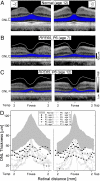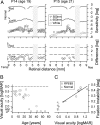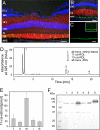Human cone photoreceptor dependence on RPE65 isomerase
- PMID: 17848510
- PMCID: PMC1986623
- DOI: 10.1073/pnas.0706367104
Human cone photoreceptor dependence on RPE65 isomerase
Abstract
The visual (retinoid) cycle, the enzymatic pathway that regenerates chromophore after light absorption, is located primarily in the retinal pigment epithelium (RPE) and is essential for rod photoreceptor survival. Whether this pathway also is essential for cone photoreceptor survival is unknown, and there are no data from man or monkey to address this question. The visual cycle is naturally disrupted in humans with Leber congenital amaurosis (LCA), which is caused by mutations in RPE65, the gene that encodes the retinoid isomerase. We investigated such patients over a wide age range (3-52 years) for effects on the cone-rich human fovea. In vivo microscopy of the fovea showed that, even at the youngest ages, patients with RPE65-LCA exhibited cone photoreceptor loss. This loss was incomplete, however, and residual cone photoreceptor structure and function persisted for decades. Basic questions about localization of RPE65 and isomerase activity in the primate eye were addressed by examining normal macaque. RPE65 was definitively localized by immunocytochemistry to the central RPE and, by immunoblotting, appeared to concentrate in the central retina. The central retinal RPE layer also showed a 4-fold higher retinoid isomerase activity than more peripheral RPE. Early cone photoreceptor losses in RPE65-LCA suggest that robust RPE65-based visual chromophore production is important for cones; the residual retained cone structure and function support the speculation that alternative pathways are critical for cone photoreceptor survival.
Conflict of interest statement
The authors declare no conflict of interest.
Figures




Similar articles
-
Pharmacological Amelioration of Cone Survival and Vision in a Mouse Model for Leber Congenital Amaurosis.J Neurosci. 2016 May 25;36(21):5808-19. doi: 10.1523/JNEUROSCI.3857-15.2016. J Neurosci. 2016. PMID: 27225770 Free PMC article.
-
Lentiviral gene transfer of RPE65 rescues survival and function of cones in a mouse model of Leber congenital amaurosis.PLoS Med. 2006 Oct;3(10):e347. doi: 10.1371/journal.pmed.0030347. PLoS Med. 2006. PMID: 17032058 Free PMC article.
-
Loss of cone photoreceptors caused by chromophore depletion is partially prevented by the artificial chromophore pro-drug, 9-cis-retinyl acetate.Hum Mol Genet. 2009 Jun 15;18(12):2277-87. doi: 10.1093/hmg/ddp163. Epub 2009 Apr 1. Hum Mol Genet. 2009. PMID: 19339306 Free PMC article.
-
Leber congenital amaurosis due to RPE65 mutations and its treatment with gene therapy.Prog Retin Eye Res. 2010 Sep;29(5):398-427. doi: 10.1016/j.preteyeres.2010.04.002. Epub 2010 Apr 24. Prog Retin Eye Res. 2010. PMID: 20399883 Free PMC article. Review.
-
Vitamin A and Vision.Subcell Biochem. 2016;81:231-259. doi: 10.1007/978-94-024-0945-1_9. Subcell Biochem. 2016. PMID: 27830507 Review.
Cited by
-
Pseudo-fovea formation after gene therapy for RPE65-LCA.Invest Ophthalmol Vis Sci. 2014 Dec 23;56(1):526-37. doi: 10.1167/iovs.14-15895. Invest Ophthalmol Vis Sci. 2014. PMID: 25537204 Free PMC article. Clinical Trial.
-
Chemical chaperone TUDCA preserves cone photoreceptors in a mouse model of Leber congenital amaurosis.Invest Ophthalmol Vis Sci. 2012 Jun 5;53(7):3349-56. doi: 10.1167/iovs.12-9851. Invest Ophthalmol Vis Sci. 2012. PMID: 22531707 Free PMC article.
-
Self-complementary AAV-mediated gene therapy restores cone function and prevents cone degeneration in two models of Rpe65 deficiency.Gene Ther. 2010 Jul;17(7):815-26. doi: 10.1038/gt.2010.29. Epub 2010 Mar 18. Gene Ther. 2010. PMID: 20237510 Free PMC article.
-
From mouse to human: Accessing the biochemistry of vision in vivo by two-photon excitation.Prog Retin Eye Res. 2023 Mar;93:101170. doi: 10.1016/j.preteyeres.2023.101170. Epub 2023 Feb 12. Prog Retin Eye Res. 2023. PMID: 36787681 Free PMC article. Review.
-
Assays for inverse agonists in the visual system.Methods Enzymol. 2010;485:213-24. doi: 10.1016/B978-0-12-381296-4.00012-9. Methods Enzymol. 2010. PMID: 21050919 Free PMC article.
References
Publication types
MeSH terms
Substances
Grants and funding
LinkOut - more resources
Full Text Sources
Molecular Biology Databases
Research Materials

